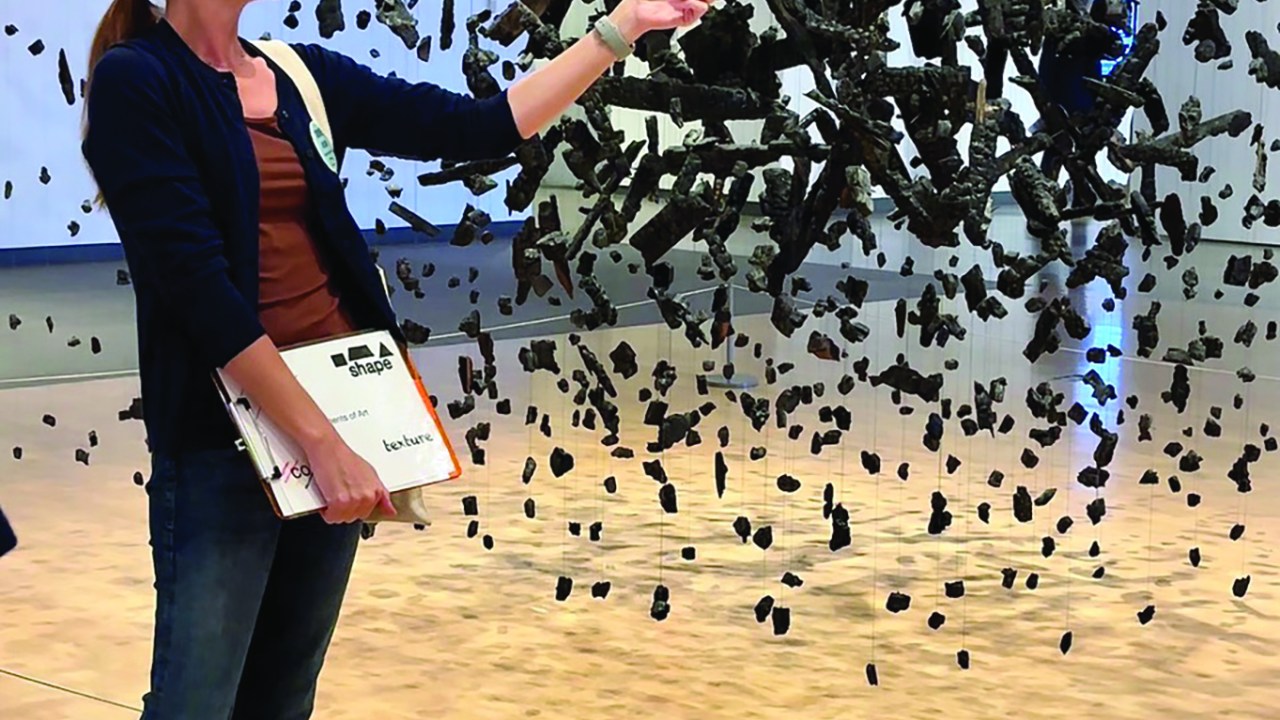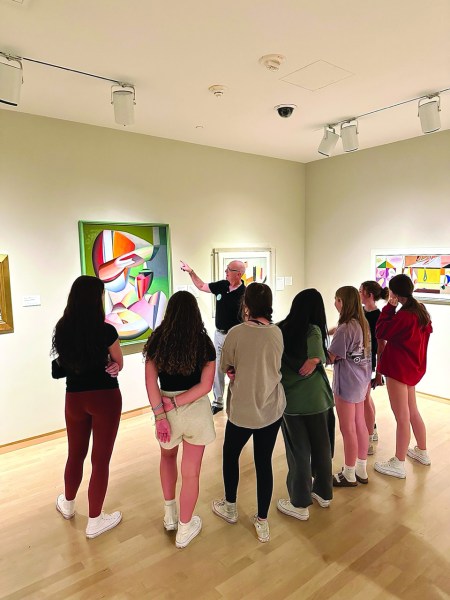
This article originally appeared in Museum magazine’s March/April 2024 issue, a benefit of AAM membership.
Docent programs that evolve with the times will continue to serve their museums and communities well.
Twenty-three years ago, I sat in the second row of a docent training class unsure of what I had signed up for. As a new docent recruit at Phoenix Art Museum in Arizona, I had embarked on a rigorous two-year program that would prepare me to offer museum tours and give community and school talks. We applied extensive art history lessons, research, and tour practice to complete a series of milestones. Upon “graduating,” a docent was qualified to tour students from grade school through high school in addition to adult visitors. We were being trained to do it all.
Sharing information—a lot of it—was a key element of every tour. Developing presentation skills and (often rhetorical) questions built our touring chops, allowing us to find the balance between providing relevant content and helping visitors relate to an object.
Over the past 15 years, however, touring shifted from a focus on what the docent has to say to what the audience wants to know. Today, there is no doubt that touring is a craft that requires knowledge, planning, attunement, and a big dose of “follow the group’s lead.”
The evolution has continued, gradually and seemingly all at once. The COVID-19 pandemic halted and, in many museums, decimated department staff and docent corps. Those who remained worked together to reach audiences who could no longer come to them. Docents strategized, organized, and skilled-up to deliver virtual programs that had not previously existed. Study groups, “shareathons,” peer-to-peer online tours, and Zoom continuing education programs kept many docents engaged and ready when the doors reopened. Organizations such as the National Docent Symposium Council (NDSC) fostered a sense of community through regional virtual roundtable conversations, webinars, and a docent Facebook group with more than 1,600 participants.
As institutions continue to recover from the pandemic, every aspect of the museum ecosystem is being examined, including the role of volunteer educators. While some museums have chosen to discontinue their docent programs, others have launched such programs for the first time. During this period of rebuilding, a renewal is occurring that I believe will make room for a new generation of docents.
How the NDSC Helps
The notion that docents can learn from one another was behind the NDSC’s creation. Founded 40 years ago with a mission to promote continuous improvement in docent practice, the NDSC supports a biennial docent conference that continues to this day. The High Museum of Art in Atlanta will host several hundred docents this November. The organization has also stepped fully into the digital realm, offering website resources, touring handbooks, and webinars such as “The Evolving Docent,” “Diversifying the Docent Corps,” and “Reconsidering Visitor Engagement.”
As a volunteer-led council of 30 members, we are active docents in our institutions. We learn about what is happening with docents in small towns and big cities across the US and Canada. And we experience firsthand how the pandemic and social justice issues impact our own roles and practices. It is a unique vantage point that does not produce easy answers and solutions but helps us recenter our focus and priorities.
Directors on the NDSC serve in various roles, including representing the six regions of the US, as delineated by AAM, and Canada. These regional directors host periodic virtual conversations via Zoom to get a read on museum and docent trends. (See the “Identifying Docent Trends” sidebar on p. 20 for a synopsis of a recent roundtable hosted by the Western Region of the National Docent Symposium Council.)
The Evolution Continues
In an effort to diversify the docent corps, traditional training methods are giving way to hybrid programs that offer a focused, flexible approach to volunteerism. While a fifth grade class requires a docent who is available on a weekday, many tours, “ask me” shifts, hands-on activities, and special events present other opportunities to serve.

At Phoenix Art Museum, a new training program launched two years ago combines 8- to 12-week modules, a blend of in-person and online learning, and varied class times and days that allow trainees to choose their path to earning a docent badge. All docents have access to continuing education programs, whether attending in person twice a month, viewing class recordings, or participating in periodic weeknight and weekend programs. I support, and am encouraged by, these changes to increase diversity and inclusivity in our, and other, docent corps. There is more to do, but we are moving in the right direction.
Docent programs, along with the institutions they serve, must continually evolve in order to stay relevant. Over the past century, the docent has shifted from expert to facilitator, and in the future our role will further progress to keep our audience front and center. I am learning and growing in my docent practice as much today as when I started two decades ago.
Jane Chu, former National Endowment for the Arts chair, was the keynote speaker at the 2022 National Docent Symposium. In her speech, she said she sees docents as innovators, serving a vital role during one of the most important times to be an educator in several generations. Despite the challenges museums have experienced as a result of the pandemic, now, more than ever, people are yearning for meaning and belonging. Chu encouraged docents to connect to people outside of the arts and have conversations that celebrate the distinctiveness of cultures and styles. Embrace the “messy message,” she challenged, as we navigate through uncertainty together. I couldn’t agree more.
Identifying Docent Trends
In June 2023, the Western Region of the National Docent Symposium Council hosted a roundtable titled “Reimagining Docent Training.” Over 50 docents attended, representing 21 museums from six states. Given that museums and their docent organizations across the region were in the process of adapting and replenishing their docent corps, the topic struck a chord.
Registrants were asked in advance to consider the following questions: What changes, if any, has your museum or docent organization made in training new docents? Was training initiated and led by docents or by the museum?
- Docents came prepared to participate and identified the following trends:
- Recruitment is now aimed at a younger, more diverse group.
- Delivery and timing of training must change to accommodate a more diverse group of trainees. These changes include self-guided materials, self-scheduled online training, training on weekends or in the evenings, and shorter training periods.
- Docent training today is more often initiated by museum staff—a change from the past when docent organizations were more autonomous.
- Training is more inquiry based, focused on open-ended questioning techniques meant to produce conversation in the galleries and empower the visitor.
- Training programs include a mentorship component, with more experienced docents pairing with new trainees for further learning.
- Training includes important information on diversity, equity, inclusion, and accessibility, and anti-racist elements.
- In addition to offering training on basic skills, museums are giving new trainees opportunities to specialize in certain aspects of the collections rather than becoming generalists.
Resources
National Docent Symposium Council
2024 National Docent Symposium in Atlanta







